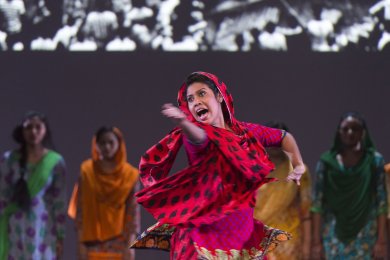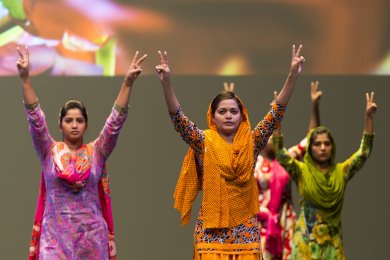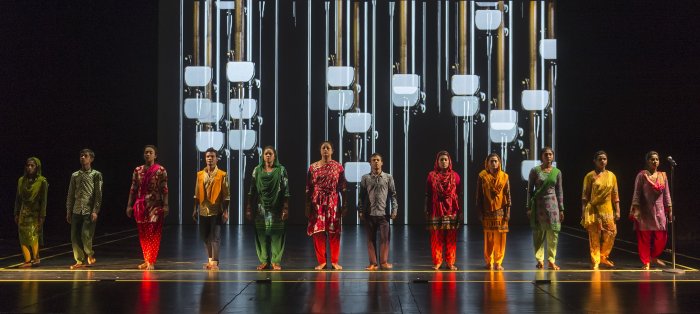
|   |

|   |
Made in Bangladesh: Stringing tales of exploitation - Sulagna Mukhopadhyay e-mail: sulagna64@gmail.com Photos courtesy: The Goethe Institut, Kolkata February 6, 2015 It was 22 January 2015. Spectators thronged in front of the Science City Auditorium in Kolkata to watch a production by Helena Waldmann. As they entered the auditorium there was a projection going on without any sound, showcasing the workers working in a sweat shop. As the curtain rose the sound of workers working in the factory could be heard. This gradually phased out with the appearance of twelve dancers standing in a straight single file and tapping their feet. Helena Waldmann, the German choreographer and theater personality was moved by the plight of the stoic garment workers of Bangladesh who earn a meager wage every day despite toiling hard. The immense competition in this world forces them to work almost 24 hours a day without any proper break for lunch or even to use the rest room. Waldmann found Kathak as the effective mode of expression for her thoughts towards these people. After conceptualizing the idea, she co-choreographed this piece with Vikram Iyengar of Ranan , Kolkata. 

She used geometrical patterns, relentless footwork, pirouettes and bols to express the different sounds of the machines and expressions of workers. The production created a dialogue between movement, sound, body and soul. A spectacular scene was the footwork in accordance with the rhythm of the giant needles of the sewing machines. The rhythm of the needles was shown through the projection at the backdrop, while the dancers’ feet kept pace with that speed. The monotony of the beats created undoubtedly boredom in the auditorium but Waldmann’s idea was to communicate the agony and the boredom of the sweatshop workers. Each set of footwork consisted of 16 beats, divided into beats of eight. She has taken out the lyrical aspects of Kathak and blended the sound of machines, sirens, honking of vehicles as the background music in the production. The second part of the production projected dancers from the West, who also face equal amount of drudgery as artists. It came as a shock to the audience when Waldmann compares the labour of a factory with that of an ‘elite class’- the artists. There is a dichotomy between the artists and the sweatshop workers - the aesthetic of art. But Helena has with subtlety broken the barrier between the two sects and brought them under one roof. In the second half, though the dancers follow the footwork of Kathak , the movement of their torsos was quite similar to that of flamenco. The costume has also contributed to this. The first half projected Asia or to be precise Bangladesh and hence the dancers were in salwar-kurta with dupatta. The second half saw the European style in the costume - short or knee-length, skin-hugging frocks and capris. Vikram Iyengar performed in the second half as the head of a production, devoid of any humanity. The master’s dictatorial attitude was aptly projected by Vikram.  Though the seamstress and dancers are world apart, they both work under constant threat of losing their job. The lighting has been effectively used in both halves of the production, creating zones for the distressed factory workers or dancers, who are forced to quit. Helena made use of sign language of the share market, which says, “If you cannot perform, you are out of the scene.” ‘Made in Bangladesh’ is a documentary dance production of Helena Waldmann and Ecotopia dance productions, in cooperation with Goethe-Institut Bangladesh and Shadhona - A Center for the Advancement of South Asian Culture. Sulagna Mukhopadhyay was trained in Bharatanatyam by Guru Thankamani Kutty and Indian folk by Late Botu Pal. She has an M.A. in Comparative Literature and has freelanced for various leading newspapers of Kolkata like The Telegraph, The Statesman and Ananda Bazar Patrika. She has written articles on dance and gender issues. She is a teacher of South Point School since 1996. |